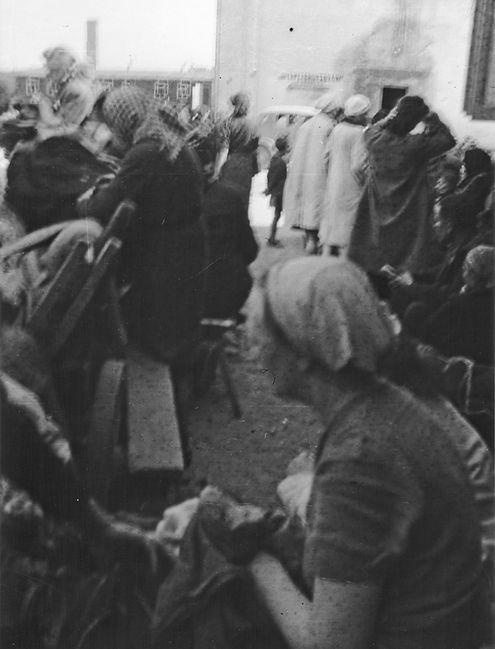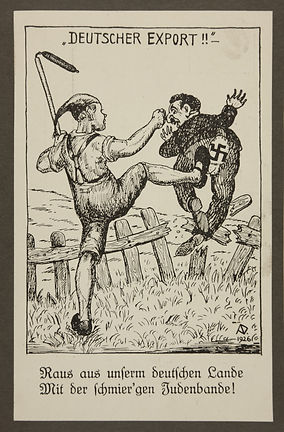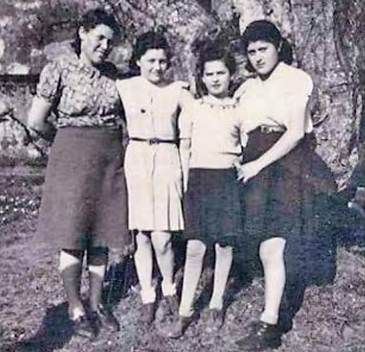Judith's Story
By Judith Dim Evans
as relayed to Lilly Filler
The story of Judith Dim Evans is a remarkable one of survival from the Holocaust as a child and fighting for survival and independence of Israel as an adolescent.
The older of two children, Judith was born Aug. 25, 1932, in Beuthen, Germany, to Jewish parents. Her father left when she was very young, and she was reared by her mom and grandmother.
Her grandmother lived a Jewish life with observance of Shabbat, reciting prayers and cooking Jewish foods, although they never went to a synagogue. Her mom was more of a creative spirit, enjoying sophisticated culture and philosophical discussions with her German friends.

Judith Dim Evans. Larry Wood / Aiken Standard

Germans pass by the broken shop window of a Jewish-owned business that was destroyed during Kristallnacht. USHMM
As a child, Judith remembered her mother’s mantra:
“Don’t worry, we are German.
Nothing will happen to you.”

On the morning after Kristallnacht local residents watch as a synagogue is destroyed by fire. USHMM
But following Kristallnacht, on Nov. 11, 1938, she remembered her mother squeezing her hand as they ran through the streets smelling the burning buildings and books, and hearing the sounds of windows crashing and breaking. She remembered seeing writing on storefronts and hearing taunts by German youth -
“DIRTY JEW”
and
“JEWS SMELL
FROM GARLIC”
An association that continued to haunt her. But as a child, she knew that this could not be true; her Jewish home was not dirty, and she did not smell of garlic!
In early 1941, Judith and her younger brother returned from school to find her mom and grandmother sewing yellow stars on all of their clothing. When she returned to school the next day, the atmosphere felt different. She was shunned and ignored by her previously friendly classmates.
Her brother got into fights and was beaten daily. Again, her mom reassured them: “Don’t worry; we are German, and nothing will happen to you.” But Judith felt isolated and alone.

A yellow Star of David badge bearing the German word 'Jude' (Jew). USHMM

Women and children at Ravensbrück concentration camp in October 1944. USHMM

Soon, her grandmother was removed from the home and placed in a ghetto, where she ultimately died. Having no adults left in the house, neighbors took the two children in, but by year’s end, they were placed in a “cloister convent,” an orphanage, supervised by nuns.
The two children were instructed to say that their father was in the military and that their mother had died. Although well treated by the nuns, Judith felt alone and began to withdraw. She could not identify as Jewish, so she did as the other children did and went through holy communion and confession.
Women and children at Ravensbrück concentration camp in
October 1944. USHMM
She became a member of the German youth groups and marched with the class, saluting -
“Heil Hitler.”
She remembered using
“green soap”
and ironically loved the smell of it, only to be told later that it was manufactured from the marrow of Jews.

SA and Hitler Youth march down a street in unidentified German town. USHMM

The orphanage embraced the German propaganda. “Übermensch” – the expression of the superior blond, blue-eyed strong men over the beautiful, blond, blue-eyed, subservient women – was espoused, and the stereotypical caricature of Jews, with big noses, long fingers and nails and dripping in blood – was perpetuated.
But Judith observed that like all the other orphans around her, none were blond and blue-eyed, but rather dark hair and dark eyes prevailed.
Antisemitic propaganda. USHMM
In May 1945, Judith began to hear about the concentration camps and the rumors of masses of Jewish deaths. The convent was secured by the Poles, and since Judith could not speak Polish, it became difficult to understand what was happening. After Allied forces liberated the orphanage, she tried to find Jewish organizations that could help her, but as a 13-year-old, looking well fed, clothed and educated in Catholicism, no one believed that she was Jewish.

The Dachau concentration camp after liberation. USHMM

Finally, her path crossed with a leader of the Zionist movement in Poland, Sarah Stern, who would later become a member of the Knesset, Israel’s governing body. Believing Judith’s incredible story, Stern secured one of the few British Certificates that would allow emigration to Palestine. After a gruelling trip, Judith arrived in Palestine in April 1946. She eventually attended an upscale boarding school in Jerusalem and had a complete education.
Judith, second left, with girls who attended her boarding school in Jerusalem.
When Israel was declared an independent state by the United Nations in November 1947, Judith joined the Haganah, the underground group fighting for Israeli independence, and served as a communicator, runner and volunteer, often finding herself in dangerous combat zones.

Judith, a Haganah volunteer, aged 16.

David Ben-Gurion pronouncing the Declaration of the State of Israel, May 14 1948
What sustained her was her mom’s mantra: “Don’t worry; nothing will happen to you.”
Independence for Israel was won in May 1948. A year later, in May 1949, Judith finished high school in Tel Aviv.
Judith became the sole manager of a refugee camp with over 250 Yemenis, and she personally pleaded with Prime Minister Ben-Gurion for more help.
Ben-Gurion sent a military company to the camp, and Judith met Chiam Dim, the military officer who became her husband. She married in 1951 and had two children.
She became an educator and school principal, the youngest in Israel, and developed a progressive curriculum for children.

Judith and her first husband, Chiam Dim, with their two children Arron and Michelle.
Chiam Dim was killed in the Six-Day War in 1967.
Continuing to work in education, often educating children of diplomats, Judith met an American, Tom Evans, in 1982. They married and moved to Aiken, South Carolina where Judith continued to speak at schools and churches about her experiences during the Holocaust and in Israel.
“I had a choice to grow up with hatred or to do something out of my experiences,” she said. “Life is a journey and you choose the road you want to walk.”
Judith Dim Evans speaking in January 2020
This article first appeared in 'Holocaust Remembered: Children of the Holocaust' produced by the Colombia Holocaust Education Commission in April 2017.
You can read the full publication here.
